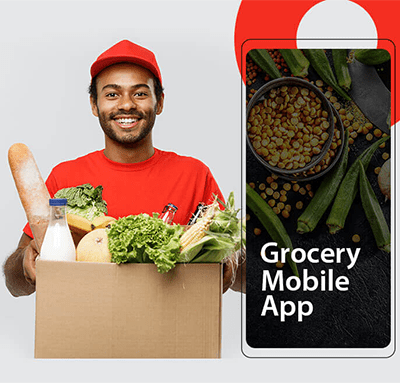
About us
Our Services
Our Expertise
Our Experience
Follow us
Why e2logy?
- We strive to provide superior customer service and ensure that every client is completely satisfied with our work.
- Our engineers are trustworthy, dedicated, and experienced and will go the extra mile to solve your IT issues.
- We are committed to delivering outstanding, cutting-edge IT solutions that add real value that goes beyond what is expected.

Grocery Delivery Mobile & Web Apps – Every detail that you ever wanted to know

There is no question that on-demand grocery delivery is growing, and it is not wrong to predict that it will be a profitable industry in the future. Using grocery shopping apps is the easiest and most convenient way to do grocery shopping if you do not want to go to the store yourself. The online supermarket sector has gained momentum because it provides convenient grocery shopping for customers with no need to travel to the store. Listed below is an article that can help you prioritize things for grocery delivery apps.
Why Build a Grocery Delivery App?
Developing grocery delivery apps may sound cliché, but the idea is quite popular today. An important factor contributing to the idea’s popularity is the overall ease it offers to the customers. In addition, the cost of developing such an app is low, which guarantees a high return on investment compared with other initiatives.
The following are a few reasons why mobile applications for grocery delivery are becoming increasingly popular.
- Saves Time and Energy: Any app delivering groceries to users makes the daily chore of shopping easier. As an alternative to standing in long lines for bill payments and carrying heavy groceries, customers can spend their time doing something more engaging and productive.
- Upgrade Your Brick and Mortar Service: Local supermarket owners cannot ignore the trend if they own an offline location. With a little investment, you can increase your customer reach by finding a grocery delivery app development company.
- A sustainable business model: This can be a good start-up business if you have a limited budget and need to start a new company quickly. It depends on the features you include in the app as to how much an online grocery app will cost.
- Easy access for customers: People now have easier access to groceries at their doorstep with online grocery delivery services. Additionally, the new standard is easier to implement because the efforts are reduced and the new normal is made easier to practice.
Types of Grocery Delivery Mobile App
1. Aggregator Apps
Aggregators usually build apps that connect several retail stores to find groceries at a competitive price. Users will be able to browse superstores and departmental stores that have been linked up. With the new application, users can order certain groceries, choose the payment method, and quick checkout. You can expect a convenient and easy process.
2. Marketplaces Apps
Buyers can place an order for a particular item by listing their store or grocery products. Deliveries of groceries from the seller to the buyer will be handled by the marketplace owner. Market owners earn income by charging commissions on transactions that take place on their marketplaces. As well, different types of deals, discounts, rewards, and coupons may be offered to lure customers to the marketplace.
3. Single Store Apps
When a single store app is used, the grocery owner commissions his branded app and supports it all, from keeping the menus updated on the website to delivering orders to customers and collecting payment.
4. Grocery chains Apps
Walmart is a great example of this business model. All order details, requests, payments, users, and many other things are managed by a single store. It has very sophisticated ways to deal with its customers. The chain supplies groceries via apps integrating aggregators and single stores.
5. Dedicated Grocery Delivery Apps
One day, perhaps, if you own a grocery business, you will think about developing an application. You must deal with several mobile shopping stages, such as making sure your app works properly, revising online menus, and managing in-app and in-store payments. If you are familiar with such cases, you should know that the number of owners’ commissions will solely depend on the quality of particular grocery business and the application for a shopper’s list. A different classification can result from considering the interface issue.
Features of a Grocery Delivery Mobile App
For Customer Panel
- Register/Login: A customer should be able to fill in basic information quickly, such as name, address, email, etc. Completing these details should make it easier for customers to log in. Social media platforms should also be available for registering.
- Browse Products: Food items and grocery items can be searched by customers to select the products they want.
- Advanced Search/Filter: Powerful and yet simple, this feature is essential. The app must offer convenient item searches for the user. App developers need to provide a variety of filter options so that users can find their desired items faster when browsing the grocery list.
- Payment Mode: Customers feel safe and secure having the choice of applying for debit/credit cards, Google Pay, and UPI payment methods integrated into their billing software.
- On-time Delivery: Delivering the products during the scheduled time and date is an integral part of the application.
- Tracking Order: SMS and mail alerts should be sent to the customer, and they should be able to discover the status of their order in real-time.
- Customer Support: It would be great if bots were integrated so they would instantly answer all users’ questions without humans getting involved.
- Modify Settings: It should be possible for users to change settings, which is they should be able to change things like contact numbers and email addresses.
- Review and Rating: Feedback for products received from stores can be left by the customers. The overall experience will improve as a result.
For Store Manager Panel
-
- Locate Store: Managers can move their stores to maps, where through the maps customers can search closed stores and make their purchases.
- Store Pickup: The Grocery App can be used to place orders and pick up orders at Grocery stores. As a result, customers will be able to do more offline grocery shopping.
- Managed Profile: Managers have full responsibility for managing store profiles. At any time and from anywhere, they can change or update their contact information, including Name, Email Address, and Phone Number.
- Live Tracking: Using GPS tracking or Google Maps, the store manager can keep an eye on the actual location of the driver, in real-time.
For Admin Panel
-
- Dashboard: This can be considered as an all-in-one solution for tracking and managing all grocery orders. This allows the business to work credible and smoothly.
- Management: A chain of multiple stores is best handled by this application. You can keep track of all orders and customers from a single location.
- Interaction with the store owner: The Grocery Delivery App’s admin panel enables managers to communicate with the app instantly and keep things glides.
- Product Listing: In the admin panel, you can change the product list and adjust the prices of the grocery products as requested by the market.
- Manage Customers: To manage customers and keep them engaged, the admin should periodically let them know about their needs and send regular notifications.
- Payment Management: The grocery business needs to manage all payment models and transparently manage them to achieve new milestones.
- Feedbacks: Feedback is collected and acted upon by the Grocery Ordering Delivery admin panel to improve the customer’s experience.
Here are a few advanced features:
-
- GPS Tracking: App development for grocery delivery must include GPS (Global Positioning System). The drivers can find the destination by using the maps, as well as the distances they need to cover. Moreover, every user and admin can be informed in real-time, so everyone is kept informed and attentive to the deliveries until completion.
- Push Notifications: The push-notification display comes up when the app is not being used. This allows you to tailor your messages and engage your customers at the right time with relevant and personalized content.
- In-app Calling and Chatting: A feature that allows both the consumer and owner of the store to contact and chat with the delivery boy could be included within the app so that both parties can communicate with them throughout the process.
- Real-time Analytics: An analysis of data that is carried out as soon as its available is known as real-time analytics. This feature allows to check users’ behaviour, detect fraud, save costs, and increase conversions and profits.
- Re-ordering: Customers who want to order the same items repeatedly can do so by re-ordering. They do not have to add the same items repeatedly.
Conclusion
Providing grocery delivery through an app sounds like a great idea, but if you do not differentiate yourself from the big names in the market, you would struggle to succeed. Connect with the right technology partners who can help take care of your grocery app and help you earn numerous profits.













